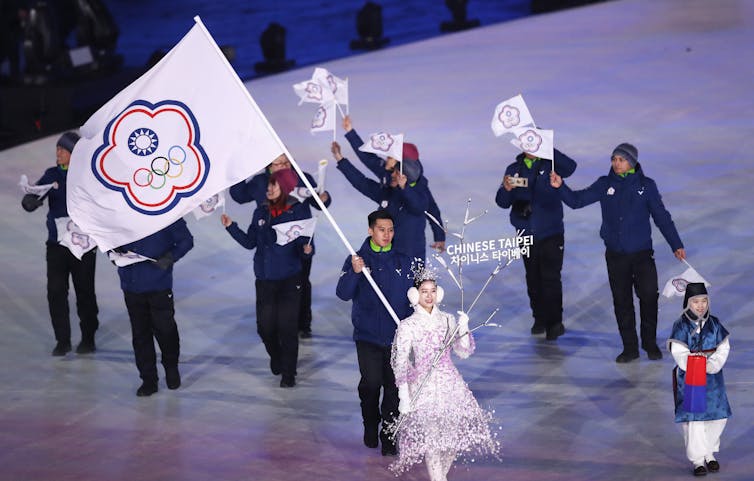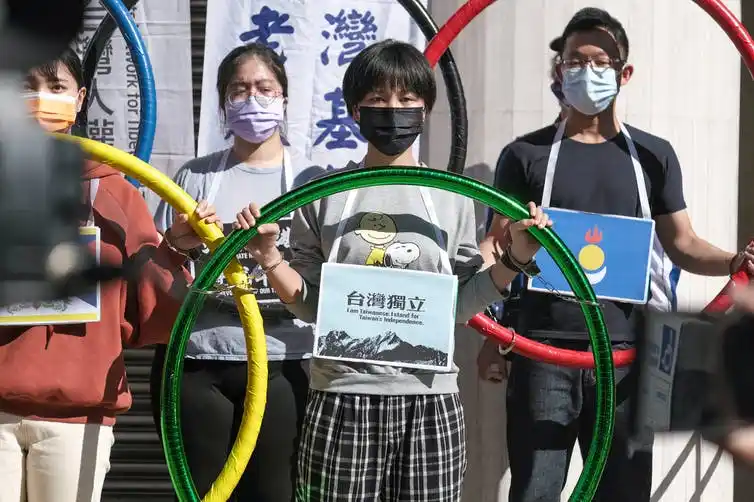By Meredith Oyen, associate professor, History and Asian Studies, UMBC
When the Beijing Olympics opens with a glitzy ceremony on Feb. 4, 2022, a tiny contingent of Taiwanese athletes will be in attendance. But they won’t be marching under the Taiwanese flag. And they will be announced as the team from “Chinese Taipei.”
They almost weren’t going to be there at all. Officials from the island had intended their athletes to be absent from the opening or closing ceremony, citing the complexity of pandemic travel. But on Feb. 1, at the behest of the International Olympic Committee (IOC), Taiwanese authorities reversed course.
COVID-19 isn’t the main issue. Behind the changing plans is a dispute over the name of the Taiwanese delegation in Olympic competition. It has its roots in the long history of contention over the status of Taiwan.
As a scholar of relations between the United States and East Asia, I also know that it is a particularly sensitive time. World attention on the Beijing Games comes amid heightened tension over Taiwan’s status, with warnings of “military conflict” if the contested island moves toward formal independence.
Competing Chinas
The status of Taiwan has been disputed since the founding of modern Communist China.
The Chinese Communist Party won its civil war against the Nationalist Party then governing as the “Republic of China” in 1949. The latter fled across the approximately 100-mile strait to the island of Taiwan, which was then still transitioning from decades of Japanese colonization.
There, the exiled Republic of China enjoyed two decades of international support as the government of “Free China.”
Led by the United States, many countries and the United Nations recognized this government on Taiwan as “China,” while refusing to recognize the new People’s Republic of China controlling the far larger mainland.
The IOC similarly only recognized the Taiwan-based government. As a result, the mainland was not represented at the Olympics throughout the 1950s and 1960s. The only Chinese team competing came from Taiwan.

In the 1970s, however, the tide began to shift. Until then, recognition of Communist China had been limited to Soviet bloc countries and newly decolonized nations in Asia and Africa.
First, in 1971, the U.N shifted recognition from the Republic of China to the People’s Republic of China. Nation after nation followed suit over the course of the decade, with the U.S. switching diplomatic recognition from Taiwan to Beijing in 1979.
Throughout this period, both the People’s Republic of China and the Republic of China on Taiwan agreed on the principle of “one China.” Both governments argued that Taiwan was part of China, and neither would allow countries or organizations to recognize both.
When the UN chose to admit the People’s Republic of China, the government in Taiwan ceased membership in the international body.
When Beijing sought admission into the IOC, it was clear that any formula that allowed athletes from both territories to compete would have to take into account the commitment to the principle of “one China.”
In 1979, the executive committee of the IOC passed a resolution that both governments ultimately agreed to follow. It admitted the People’s Republic of China under the name “Chinese Olympic Committee” and the government of Taiwan as the “Chinese Taipei Olympic Committee.”
This arrangement allowed Beijing to accept Taiwan’s inclusion in the Games by framing the island contingent as a regional branch of its national team, even though their medal counts were separate.
Taiwanese athletes would be required to compete under an alternate anthem and flag to that used by Taiwan, so as not to display Republic of China emblems.
The Republic of China in Taiwan finally agreed to compete under these terms in 1981. It had few other options, given its own past recalcitrance on the issue of allowing both governments in any formal organization. A similar formula was later adopted to allow an independent Olympic team from Hong Kong to compete after the British handed its former colony back to China in 1997.
Pushback to independence
Over the last four decades, the Republic of China on Taiwan has transformed from a colonial authoritarian regime to a democracy.
But at the same time, its international recognition as an independent government has dwindled. From 2000 to 2008 and again starting in 2016, political parties advocating Taiwan’s independence achieved electoral success at the highest levels. But this served to trigger a pushback from Beijing as it seeks to stave off what it views as growing separatism.
These tensions have spilled out into the Olympic arena.
Just last year, during the opening ceremony of the Tokyo Games, a Japanese announcer referred to the “Chinese Taipei” Olympic team as “the team from Taiwan,” lining up in the opening ceremony under “Taipei” instead of “Chinese.”
This angered mainland Chinese officials concerned about a shift away from the one China principle.
And in the run-up to the 2022 Beijing Olympics, Beijing’s Taiwan Affairs Office used a slight variation in the Chinese name for the team from “Chinese Taipei” to stress that it considered Taiwan to be a part of China. They used “zhongguo” (China) instead of “zhonghua” (Chinese). While “Zhonghua” is a broad term that refers to anything Chinese by ethnicity or heritage, “Zhongguo” refers to the country itself.
The Taiwan government vehemently opposed the altered name.
Because Taiwan is a subtropical island, it does not have a significant presence at the Winter Olympics – only four of its athletes have qualified for the forthcoming competition.
Regardless of the team’s size, Chinese authorities will be keen not to allow the issue to be a media distraction during the Beijing Games.
*****
Meredith Oyen, Associate Professor of History and Asian Studies, University of Maryland, Baltimore County
This article is republished from The Conversation under a Creative Commons license. Read the original article.
Header image: Taiwanese independence activists call for a boycott of the Beijing Games. Walid Berrazeg/Anadolu Agency via Getty Images
Tags: Asian studies, History, Research, The Conversation

